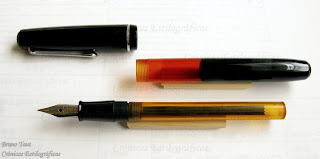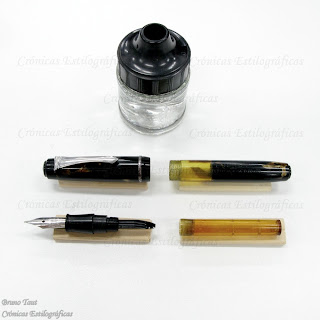Some months ago, I wrote a chronicle about a strange pen. A Pilot pen, actually, from 1938. Its most striking feature was a strangely long feed that entered well into the ink deposit for no apparent reason. This deposit, on its side, was screwed to the section. It really looked like a re-usable cartridge. But at the same time, it was also a sort of eyedropper pen with a reduced ink reservoir. That is why I named that chronicle as “Hybrid”.
Was I mistaken! Reality was a lot more exciting. And that is why my mistake was so sweet.

A short version of the previous pen, together with the nomikomi-shiki inkwell. These inkwells are really difficult to find nowadays.
This family of pens was released with an ad-hoc inkwell that allowed a very special and original filling procedure. This inkwell had a hole with a neck in the cap, inside which there are four sealing-rubber lips. To ink the pen, the user had to introduce it, uncapped, nib down, in the inkwell. Then, flip the inkwell and the pen upside down (crossing fingers for the rubber seal to work well, thus avoiding a massive ink spillage). Gravity and the capillarity of the extra-long feed worked together to fill the ink deposit very efficiently. This procedure, named nomikomi-shiki (呑込式) or, in English, easy-drink filler, can be seen on the following videoclip.
The pen used on this demonstration is a small version of the one I showed on my original, and mistaken, text. Both are made of celluloid, and have a window on the barrel to check the appropriate filling of the pen as well as the remaining ink. These are the dimensions of the short version of the nomikomi-shiki pen:
Closed: 103 mm.
Open: 94 mm.
Posted: 130 mm.
Diameter: 13 mm.
Indeed a sweet mistake as the reality proved to be a lot more interesting and original that mi initial guess.
My thanks to Mr. Niikura.
Platinum Celluloid, music nib – Sailor Kiwa-guro, 極黒
Bruno Taut
Madrid, December 11th, 2012
etiquetas: Pilot, soluciones técnicas
Bruno Taut
Madrid, December 11th, 2012
etiquetas: Pilot, soluciones técnicas

















7 comments:
Fascinating filling system. Thank you for introducing me to yet another interesting pen. I would imagine these pens are rare but I would like to try one. Kindly let me know if you know a source.
VV
Thanks for passing by and commenting.
A source of nomikomi-shiki pens? Hard to find, but I'll keep you posted.
Cheers,
BT
I was at the Chicago Pen show last weekend and bumped into Andreas Lambrou where he was promoting his latest book, Fountain Pens of Japan. He and the co-author, Masamichi Sunami, spent more than two decades researching the book and the hard work is apparent. I mentioned my discovery about these rare pens and he instantly flipped to the pages where he has covered them - great pictures too. Finally he too wished me good luck for finding one.
Thanks so much for this article. I was fortunate enough to find one of these pens at a flea market, for the princely price of one dollar. Had a really hard time identifying it; had to contact Pilot directly to get an identification. It has wear commensurate with it's age, but is in decent overall condition. The nib is a dream! Not a Waterman wet noodle, but not very far from it, either. It's the larger one with the loooong feed. Holds a LOT of ink compared to today's pens. Only downside is ink tends to pool in the feed when doing a lot of flex-writing, and unless occasionally shaken lightly over a towel, you can get a fat inkdrop on the paper. Also, if you leave it in a hot car, don't open it until you can do so over a sink or something, 'cause the cap will be full of ink. It's a daily writer for me. What I'm really going to need luck for is in finding one of those bottles.... For anyone who's interested, I have pictures of this pen posted on the Fountain Pen Network... the URL is: http://www.fountainpennetwork.com/forum/topic/338186-1930s-pilot-n30-fountain-pen/?hl=%2Bpilot+%2Bparallel+%2Bpen
As you can see you were very lucky finding such an original pen. Now be careful with it--vintage pens are delicate! Leaving it in a car? Don't do that, for god's sake.
The inkwells of this filling system are are, very rare, and expensive.
Thanks for passing by and commenting.
BT
These are the conceptual progenitor of Parker's capillary filler and the Pelikan Level system.
Very cool and innovative!
Thanks, Anonymous. You are right, this "easy drinking" system uses the same principle of capillarity as those pens you mention, but much earlier in time, and with a twist that adds risk to the operation of filling.
Thanks for passing by and commenting.
BT
Post a Comment
Your comments are welcome and appreciated.